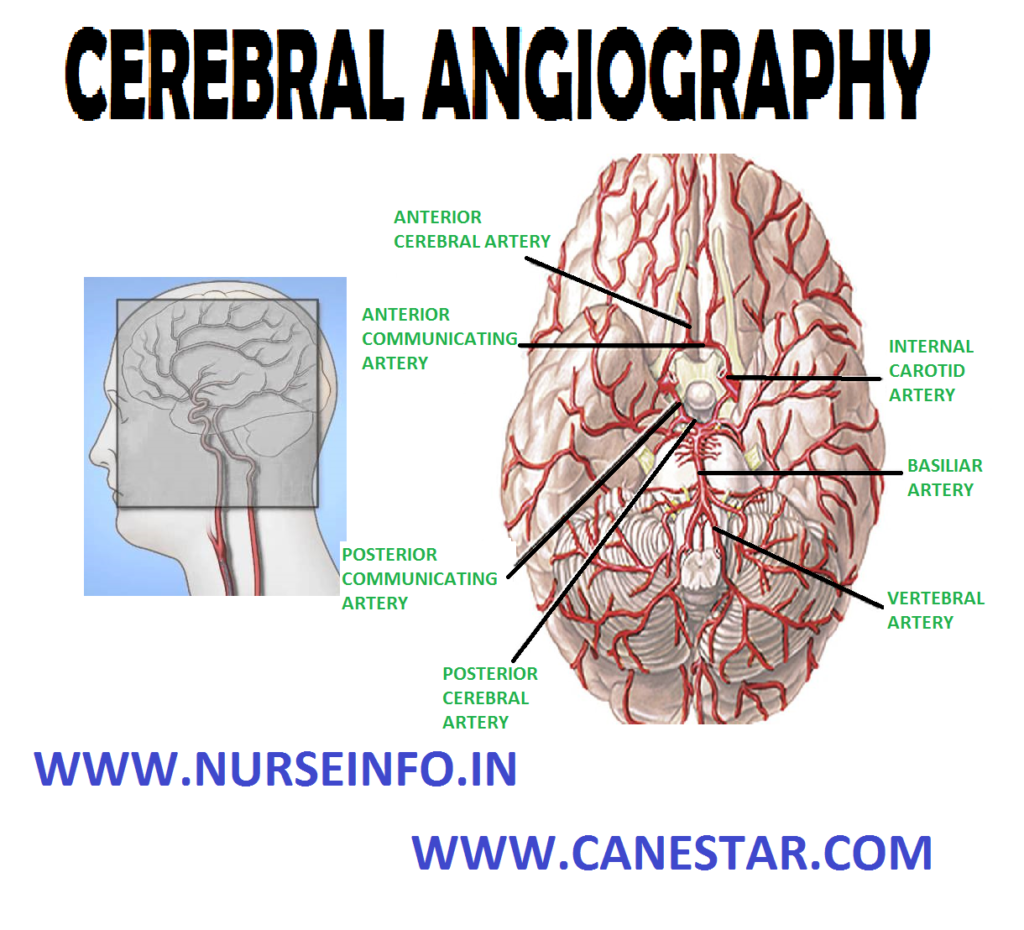CEREBRAL ANGIOGRAPHY – Definition, Purpose, General Instructions, Client Preparation, Procedure, After Care and Complications
Cerebral angiography is an X-ray study of the cerebral circulation following injection of contrast material into a selected artery. Cerebral angiography is the primary investigate tool for intracranial aneurysm, arteriovenous malfunction, cerebral vascular occultation disease and study of collateral blood flow
DEFINITION
Cerebral angiography is the X-ray study by injecting radiopaque contrast medium into an artery visualization of intracranial and extracranial blood vessels
PURPOSE
- To diagnose intracranial lesions
- To detect abnormalities of blood vessels such as stenosis, aneurysms and arteriovenous malformation
- To detect any displacement of cerebral vessels due to cysts, tumors or abscess
- To visualize the cerebral arteries and veins to determine the size and nature of pathological process
- It is done as a preparatory investigation to neurovascular interventional therapy
- It is also has values in localizing mass lesion and may aid in preparative diagnosis
- It is frequent done prior to craniotomy
GENERAL INSTRUCTIONS
- The client needs to prepare physiologically and psychologically
- The majority of cerebral angiograms are done by the transfemoral route, but the procedure may be accomplished by direct puncture of the carotid/vertebral artery or by retrograde injection of contrast medium into the brachial artery
- The skin to be shaved at puncture site, for direct puncture. In male client, beard and neck to be shaved. For transfemoral approach shaving to be done for both male and females from umbilicus to mid-thigh on both sides
- The client should be informed that the lie still during the procedure and he will feel a burning sensation during the injection for 4-6 seconds
- Indwelling catheter for female and condom connected to urosac placed for male clients
- Keep the client nothing per oral for 6-8 hours, those posted under general anesthesia
- Mark the appropriate peripheral pulses with a felt tipped pen on the skin
CLIENT PREPARATION
- Explain the procedure to the client that X-ray films will be taken from different angles during procedure
- Obtain informed consent from the client
- Remove any metal objects and jewelry from the client
- Assess the client for allergic reactions to dye
- Maintain nothing per oral before six hours to the procedure
- Perform skin preparation and remove the hair from the sites of catheter insertion
- Monitor the baseline neurological signs
- Explain the client the local anesthesia is administered before insertion of catheter
PROCEDURE
- The nurse in the angiogram room will receive the client
- The nurse explain the entire procedure thoroughly to get cooperation
- The client placed in the treatment table comfortably
- Legs and hands are fixed
- Blood pressure cuff and ECG leads are applied and connected to the monitor
- The client is hydrated with IV fluids
- Xylocain test dose given
- Painting and draping is done for femoral artery puncture
- Administration of injection heparin given after puncture
- Vital signs are monitored continuously
- At the end of puncture, heparin is neutralized by giving protamine injection
- Apply direct pressure over punctured site for 15-20 minutes
- Pressure crape bandage is applied in the punctured site
- Check the peripheral pulse after conformation shift the client to the ward
AFTER CARE
- Maintain strict bed rest for 12-24 hours
- Observe for bleeding, swelling, redness and changes in the temperature
- After bleeding stops, apply a pressure dressing and place sand bag over the dressing
- If the punctured site is femoral artery, the leg is immobilized for 24 hours to prevent bleeding
- Monitor vital signs and neurological signs
- Icebags may also be used to provide pressure and relieve tenderness
COMPLICATIONS
- Cerebral embolus caused by the catheter dislodging a segment of atherosclerotic plaques in the vessel
- Hemorrhage or clot formation at the insertion site
- Vasospasm of a vessel caused by the irritation of catheter placement
- Thrombosis of the extremity distal to the injection site
- Allergic reaction to the contrast medium


